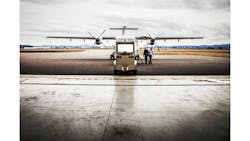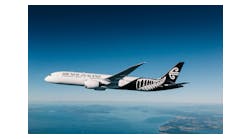The Regional Airline Association (RAA) celebrated its 25th anniversary in 2000, and in 2015 will mark its 40th birthday during its annual convention in Cleveland, May 11-14. During the past four decades, while the regional airline industry has overcome a vast number of challenges — regulatory changes, growth/consolidation, new business models, rising fuel prices, the effects of 9-11 and the introduction of new aircraft types — it remains a sector able to adapt and re-define itself always fulfilling its critical role to provide scheduled service to communities and its mainline partners.
Through all these memorable events, RAA has remained the strong industry advocate in Washington, D.C., bringing the unique regional airline message to the media and traveling public. These successful efforts have secured the regional airline industry a seat at the table at FAA, on Capitol Hill, and across Washington, D.C., as these decision makers adopt policies and regulations affecting the nation’s air transportation system.
THEN…
RAA’s original charter is just as relevant today as when the association was founded in 1975 (then called the Commuter Airline Association of America) — to promote a healthy business climate and to work with regulatory agencies and other organizations, including the traveling public, with an objective of achieving safety, efficiency, and growth of the regional airlines.
The burning issues of the association during its first meeting under the leadership of Chairman Art Horst and President Thomas Miles centered on commuter access to airports — airside and landside and industry/travel agent automated reservation systems. During the “coffee and coke breaks,” sponsored by the likes of Shorts Brothers and Harland Ltd., more than 325 organizations, including 88 airlines, listened to Congressman Glenn Anderson underline the critically important role commuters played in connecting small communities with larger hubs.
In 1975, commuters provided air service at 149 cities with a population of fewer than 25,000. Commuters also serviced 81 cities with populations of between 25,000 and 100,000. The industry enplaned nearly 6.8 million passengers, 60 percent more than in 1970 when they carried 4.2 million. The commuter fleet at the time totaled 962 aircraft — 145 single-engine piston aircraft, 565 multi-engine piston, and 252 turbines. Four manufacturers accounted for more than 73 percent of the aircraft: Beech, Cessna, Piper, and de Havilland.
During the next 25 years, the industry transitioned from six- to nine-seat piston twins through the first generation turboprop-powered aircraft to the high-speed turboprops and regional jets of the 21st century. The first ever RJ was the Rolls-Royce powered VFW614 launched in 1976 with the tagline: “When business propels you out of the props.” It was to be a short-lived program as fuel prices rocketed, and the airlines remained loyal to the traditional workhorses — the turboprops. Like the Concorde, industry observers opined the 614 was before its time.
Attending his first RAA meeting in 1980, Fairchild President Carl Albert was then a passive investor in Wings West Airlines. “I remember sitting at breakfast with an incredible group of entrepreneurs discussing the latest mods to their aircraft … about five years later those same RAA breakfasts brought together a different cast of characters. The airline presidents had changed from entrepreneurs to investment bankers,” Albert said.
When RAA marked its 25th year during its 2000 annual convention in San Antonio, the regional jet explosion was continuing apace. Numerous airline members were taking delivery of new RJs, including Atlantic Coast’s first Fairchild 328JET, Express Airline I’s first Canadair CRJ, and Mesa’s first Embraer 145. RJs were filling the skies, and the Bombardier CRJ emerged as the fleet leader. The U.S. regional airlines collectively operated 2,187 aircraft in 2000, and it was the first time in the history of RAA a regional jet took the No. 1 position as the fleet leader with the most regional lift capacity at 14.12 percent and 184 aircraft in service.
The 25 largest regional airlines, most of which had large fleets of RJs and high-performance turboprops, carried 96 percent of the 78 million regional airline passengers. The nearly 10 percent year-over-year growth reflected an increased effectiveness of the code-sharing arrangements between regional and their major partners.
Another new industry trend in 2000 was the arrival of more business-to-business and e-commerce companies at the association’s annual convention. Air traffic control issues, pilot flight and duty time, and aviation security were critical problems the association were faced with.
NOW …
While passenger enplanements for 2013 dipped to 156.97 million (compared with 161.73 million in 2012), regional airlines continued to serve 614 U.S. airports. Notably, 431 of those airports, or 70 percent of all commercial airports, rely exclusively on regional airlines for their community’s only scheduled service. (See Industry Stat charts and maps)
Today, only 49 regionals account for 100 percent of the regional airline enplanements totaling nearly 160 million with a handful of carriers representing the largest portion of these enplanements. As the mainline carriers have now consolidated: United/Continental; American/USAirways; Delta/Northwest. RAA’s current 29 airline members are involved in multiple code-sharing partnerships and have themselves merged as well. They are: SkyWest and ExpressJet; Republic/Chautauqua/Shuttle America under the Republic Holdings company; American now owns Envoy (formerly American Eagle) as well as Piedmont and PSA Airlines (formerly owned by USAirways), and Delta-owned Endeavor; and Compass/GoJet/Trans States Airlines operates as a family of Trans States Holdings. Mesa, Horizon Air, Air Wisconsin, and Commutair round out the Top 10 Carrier Group ranking of 2013.
2014 is shaping up to be one of the most momentous years in RAA’s nearly 40-year history. Today, the national airline industry stands on the precipice of a massive shortage of commercial pilots. This shortage has been worsened by a series of regulatory changes that have moved the goalposts for current student pilots and made it difficult for would-be pilots to pursue an aviation career.
This game-changing event has already affected the industry with nearly 90 communities losing at least 10 percent of their daily flights, and the media headlines tell this sad tale:
- United’s announcement to retire about 130 50-seaters coupled with the airline’s earlier decision to shrink its Cleveland hub by 70 percent
- Great Lakes’ service suspensions in 10 communities across six states
- Republic plans to park 27 regional jets
- Silver retiring its 19-seaters and ending service to six cities across four states
- More than 1,000 jobs and counting.
The story will continue as analysts show that more than 200 additional airports are “at risk” of losing all service or shrinking flight frequency, thereby disconnecting these communities from the global economy.
RAA has built a platform to shine a spotlight on this issue and rally Congress to ask the FAA to provide credit for high quality, structured training programs ensuring the pipeline that has been severed for future aviators is fixed. The online campaign is called Take Flight Tomorrow (www.takeflighttomorrow.org), and it serves as a central place for resources, news stories, and videos to be shared as thousands of stakeholders and interested parties spread the word with their customers, supplier,s and other business partners to help the footprint grow across the nation. Utilizing social media platforms, the coalition’s network of supporters continues to gain momentum by telling their real-life stories to Congressional representatives and regulatory agencies of just how significant the lack of qualified pilots is affecting their communities with reduced jobs and cuts in service and the resulting economic losses by being disconnected from scheduled airline service.
The regional airline story -- over the past 40 years -- is rich in strategic developments, regulatory changes and business model adjustments. Through it all, RAA has been a guiding force and an important voice for this critical segment of the nation’s air transportation system. RAA welcomes all stakeholders to celebrate its 40th anniversary in Cleveland next May 2015 when it will chart its course for the years to come.
Kelly Murphy has been involved with the U.S. Regional Airline Association since the mid-1980s when she was editor of the weekly newsletter Commuter/Regional Airline News. After establishing Emerald Media with her UK partner Alison Chambers in 1993, the two launched daily newsletter publications covering both the annual RAA Convention and the ERA General Assembly. In 2015, during the RAA 40th Annual Convention, Emerald Media will also mark the 21st year of publishing the special convention newsletters. Kelly also handles all media relations for RAA and publishes the quarterly Regional Horizons magazine as well as the RAA Annual Report.





